“The Future of Bio-mech”
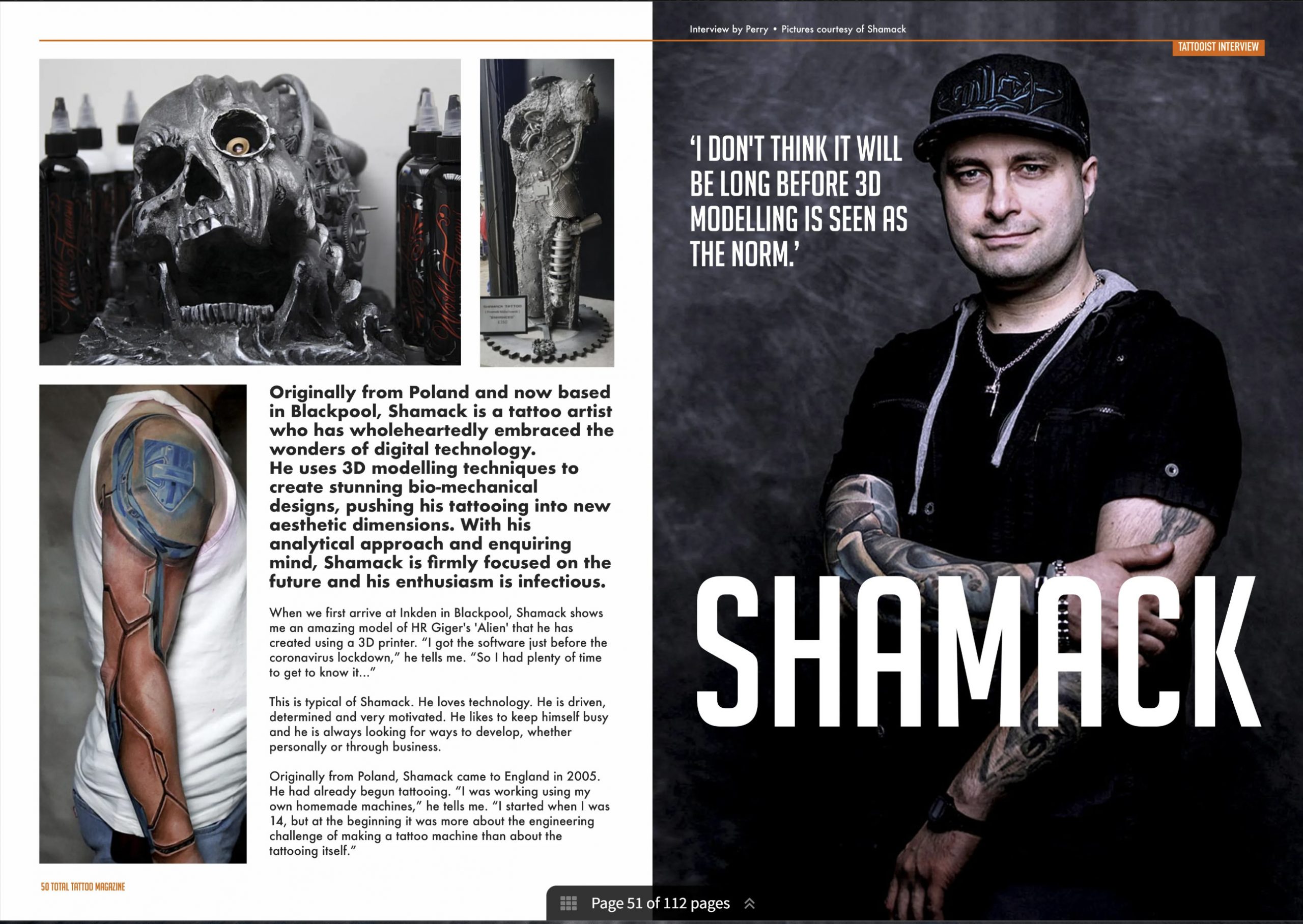
who has wholeheartedly embraced the wonders of digital technology.
He uses 3D modelling techniques to create stunning bio-mechanical designs, pushing his tattooing into new aesthetic dimensions. With his
analytical approach and enquiring mind, Shamack is firmly focused on the future and his enthusiasm is infectious.
When we first arrive at Inkden in Blackpool, Shamack shows me an amazing model of HR Giger’s ‘Alien’ that he has
created using a 3D printer. “I got the software just before the coronavirus lockdown,” he tells me. “So I had plenty of time
to get to know it…” This is typical of Shamack. He loves technology. He is driven,
determined and very motivated. He likes to keep himself busy and he is always looking for ways to develop, whether
personally or through business. Originally from Poland, Shamack came to England in 2005.
He had already begun tattooing. “I was working using my own homemade machines,” he tells me. “I started when I was
14, but at the beginning it was more about the engineering challenge of making a tattoo machine than about the tattooing itself.”
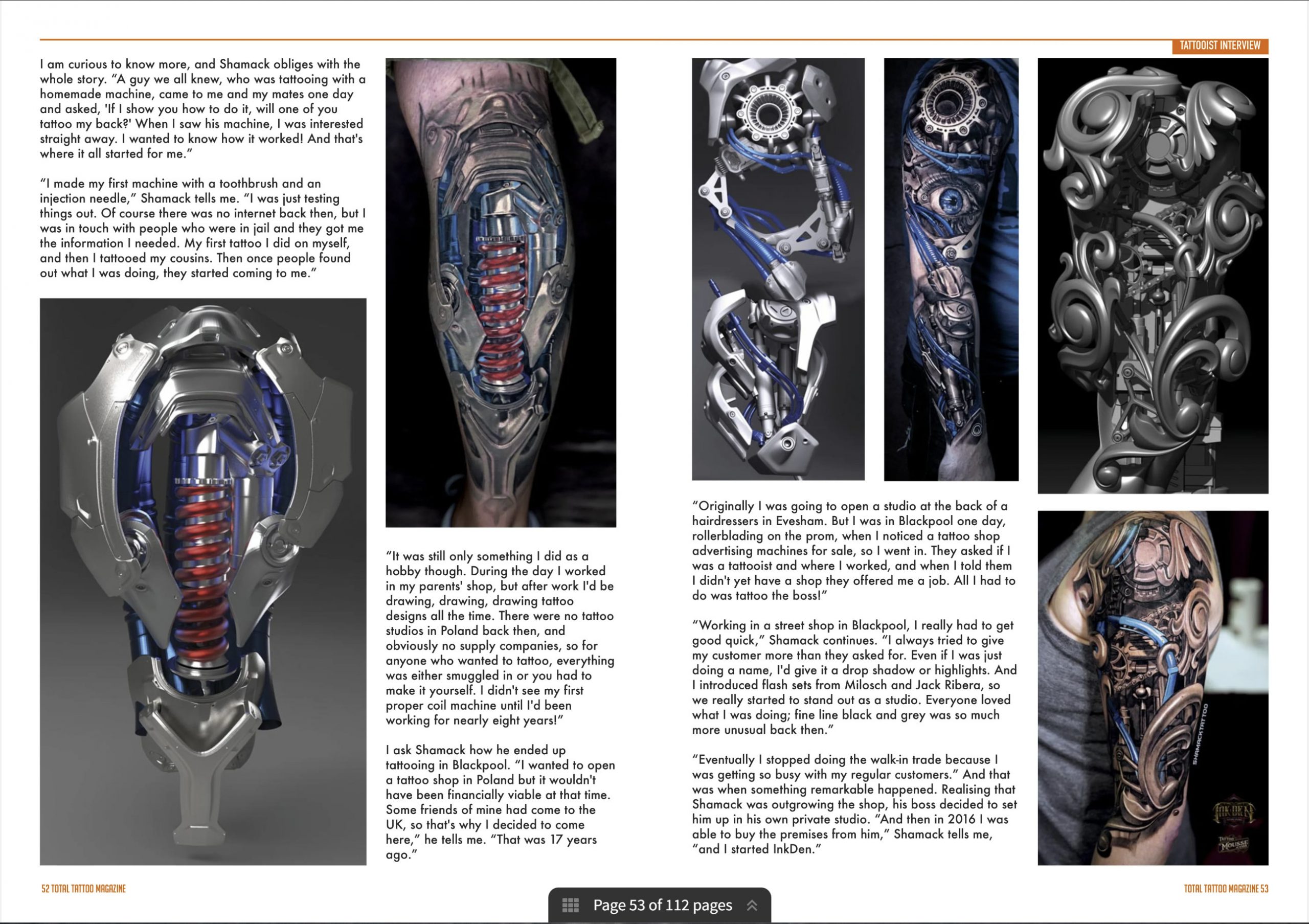
homemade machine, came to me and my mates one day and asked, ‘If I show you how to do it, will one of you
tattoo my back?’ When I saw his machine, I was interested straight away. I wanted to know how it worked! And that’s
where it all started for me.”
“I made my first machine with a toothbrush and an injection needle,” Shamack tells me. “I was just testing
things out. Of course there was no internet back then, but I was in touch with people who were in jail and they got me
the information I needed. My first tattoo I did on myself, and then I tattooed my cousins. Then once people found
out what I was doing, they started coming to me.” “It was still only something I did as a
hobby though. During the day I worked in my parents’ shop, but after work I’d be drawing, drawing, drawing tattoo
designs all the time. There were no tattoo studios in Poland back then, and obviously no supply companies, so for
anyone who wanted to tattoo, everything was either smuggled in or you had to make it yourself. I didn’t see my first
proper coil machine until I’d been working for nearly eight years!”
I ask Shamack how he ended up tattooing in Blackpool. “I wanted to open a tattoo shop in Poland but it wouldn’t
have been financially viable at that time. Some friends of mine had come to the UK, so that’s why I decided to come
here,” he tells “That was 17 years ago.”
“Originally I was going to open a studio at the back of a hairdressers in Evesham. But I was in Blackpool one day,
rollerblading on the prom, when I noticed a tattoo shop advertising machines for sale, so I went in. They asked if I
was a tattooist and where I worked, and when I told them I didn’t yet have a shop they offered me a job. All I had to
do was tattoo the boss!”
“Working in a street shop in Blackpool, I really had to get good quick,” Shamack continues. “I always tried to give
my customer more than they asked for. Even if I was just doing a name, I’d give it a drop shadow or highlights. And
I introduced flash sets from Milosch and Jack Ribera, so we really started to stand out as a studio. Everyone loved
what I was doing; fine line black and grey was so much more unusual back then.”
“Eventually I stopped doing the walk-in trade because I was getting so busy with my regular customers.” And that
was when something remarkable happened. Realising that Shamack was outgrowing the shop, his boss decided to set
him up in his own private studio. “And then in 2016 I was able to buy the premises from him,” Shamack tells me,
“and I started InkDen.”
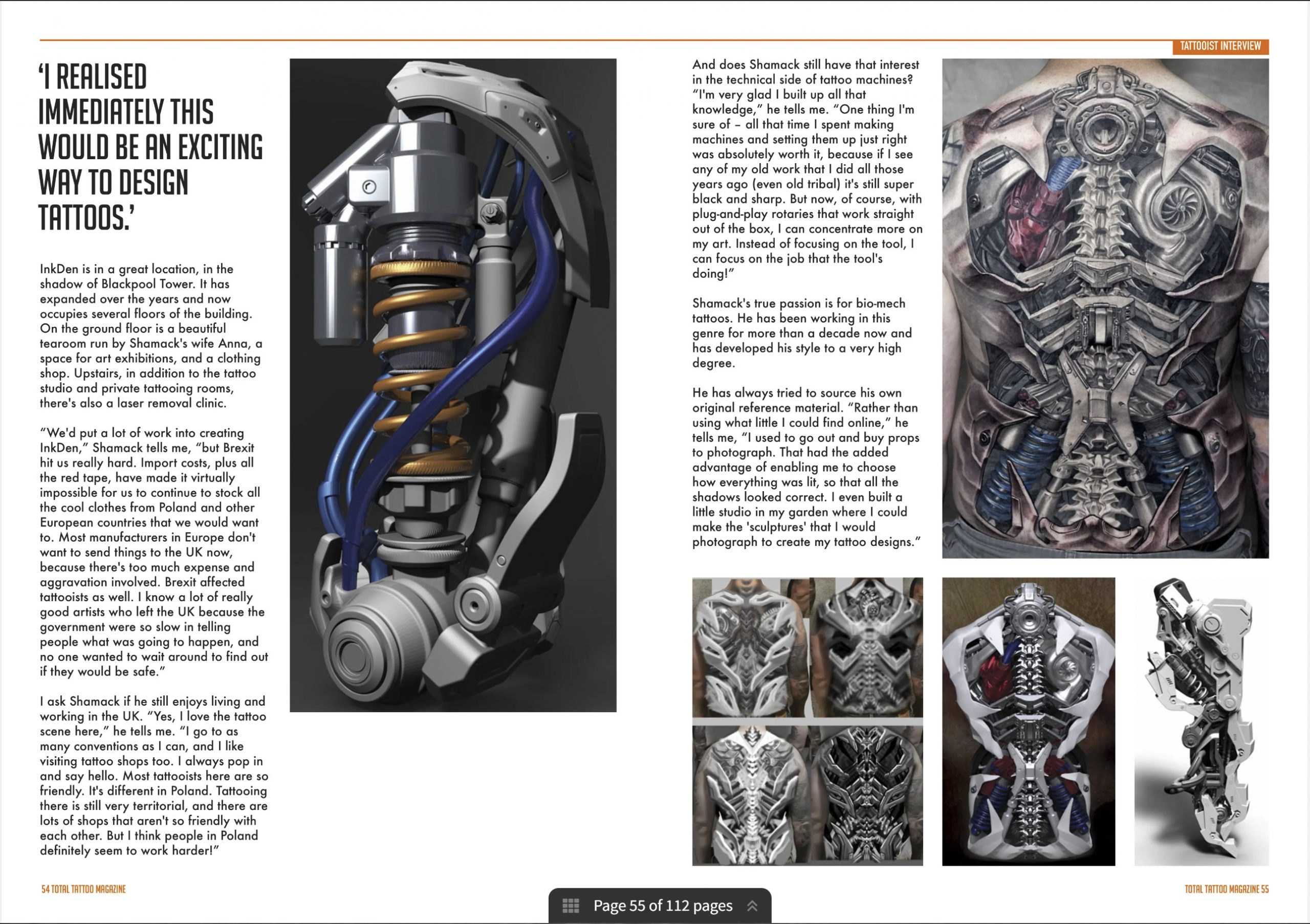
InkDen is in a great location, in the shadow of Blackpool Tower. It has expanded over the years and now
occupies several floors of the building. On the ground floor is a beautiful tearoom run by Shamack’s wife Anna, a
space for art exhibitions, and a clothing shop. Upstairs, in addition to the tattoo studio and private tattooing rooms,
there’s also a laser removal clinic. “We’d put a lot of work into creating InkDen,” Shamack tells me, “but Brexit
hit us really hard. Import costs, plus all the red tape, have made it virtually impossible for us to continue to stock all
the cool clothes from Poland and other European countries that we would want to. Most manufacturers in Europe don’t
want to send things to the UK now, because there’s too much expense and aggravation involved. Brexit affected
tattooists as well. I know a lot of really good artists who left the UK because the government were so slow in telling
people what was going to happen, and no one wanted to wait around to find out if they would be safe.”
I ask Shamack if he still enjoys living and working in the UK. “Yes, I love the tattoo scene here,” he tells me. “I go to as
many conventions as I can, and I like visiting tattoo shops too. I always pop in and say hello. Most tattooists here are so
friendly. It’s different in Poland. Tattooing there is still very territorial, and there are lots of shops that aren’t so friendly with
each other. But I think people in Poland definitely seem to work harder!”
And does Shamack still have that interest in the technical side of tattoo machines?
“I’m very glad I built up all that knowledge,” he tells me. “One thing I’m sure of all that time I spent making
machines and setting them up just right was absolutely worth it, because if I see any of my old work that I did all those
years ago (even old tribal) it’s still super black and sharp. But now, of course, with plug-and-play rotaries that work straight
out of the box, I can concentrate more on my art. Instead of focusing on the tool, I can focus on the job that the tool’s doing!”
Shamack’s true passion is for bio-mech tattoos. He has been working in this genre for more than a decade now and
has developed his style to a very high degree. He has always tried to source his own original reference material. “Rather than
using what little I could find online,” he tells me, “I used to go out and buy props to photograph. That had the added
advantage of enabling me to choose how everything was lit, so that all the shadows looked correct. I even built a
little studio in my garden where I could make the ‘sculptures’ that I would photograph to create my tattoo designs.”
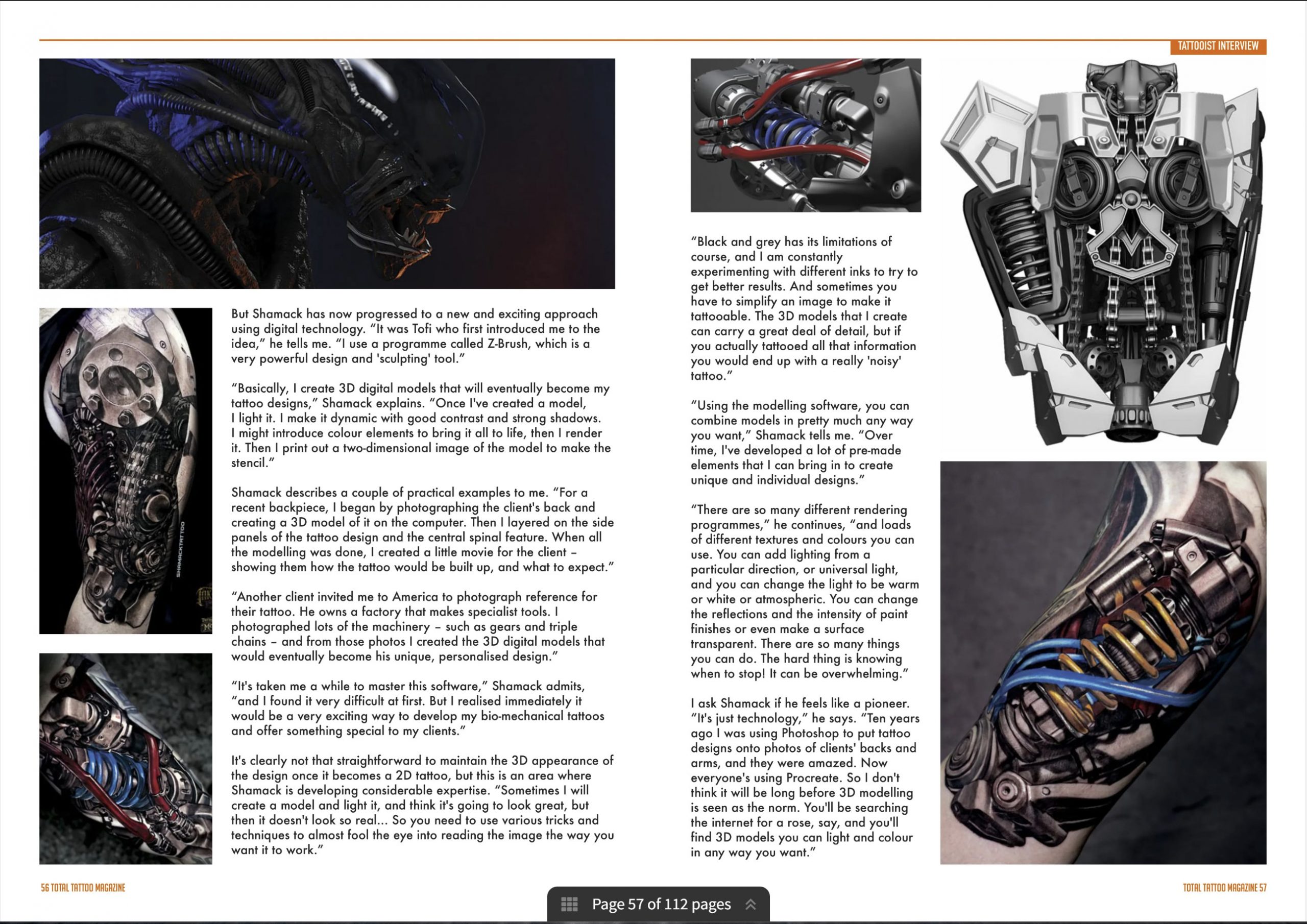
idea,” he tells me. “I use a programme called Z-Brush, which is a very powerful design and ‘sculpting’ tool.”
“Basically, I create 3D digital models that will eventually become my tattoo designs,” Shamack explains. “Once I’ve created a model,
I light it. I make it dynamic with good contrast and strong shadows. I might introduce colour elements to bring it all to life, then I render
it. Then I print out a two-dimensional image of the model to make the stencil.”
Shamack describes a couple of practical examples to me. “For a recent backpiece, I began by photographing the client’s back and
creating a 3D model of it on the computer. Then I layered on the side panels of the tattoo design and the central spinal feature. When all
the modelling was done, I created a little movie for the client – showing them how the tattoo would be built up, and what to expect.”
“Another client invited me to America to photograph reference for their tattoo. He owns a factory that makes specialist tools. I
photographed lots of the machinery – such as gears and triple chains – and from those photos I created the 3D digital models that
would eventually become his unique, personalised design.” “It’s taken me a while to master this software,” Shamack admits,
“and I found it very difficult at first. But I realised immediately it would be a very exciting way to develop my bio-mechanical tattoos
and offer something special to my clients.” It’s clearly not that straightforward to maintain the 3D appearance of
the design once it becomes a 2D tattoo, but this is an area where Shamack is developing considerable expertise. “Sometimes I will
create a model and light it, and think it’s going to look great, but then it doesn’t look so real… So you need to use various tricks and
techniques to almost fool the eye into reading the image the way you want it to work.” “Black and grey has its limitations of
course, and I am constantly experimenting with different inks to try to get better results. And sometimes you have to simplify an image to make it
tattooable. The 3D models that I create can carry a great deal of detail, but if you actually tattooed all that information
you would end up with a really ‘noisy’ tattoo.” “Using the modelling software, you can combine models in pretty much any way
you want,” Shamack tells me. “Over time, I’ve developed a lot of pre-made elements that I can bring in to create unique and individual designs.”
“There are so many different rendering programmes,” he continues, “and loads of different textures and colours you can
use. You can add lighting from a particular direction, or universal light, and you can change the light to be warm
or white or atmospheric. You can change the reflections and the intensity of paint finishes or even make a surface
transparent. There are so many things you can do. The hard thing is knowing when to stop! It can be overwhelming.”
I ask Shamack if he feels like a pioneer. “It’s just technology,” he says. “Ten years ago I was using Photoshop to put tattoo
designs onto photos of clients’ backs and arms, and they were amazed. Now everyone’s using Procreate. So I don’t
think it will be long before 3D modelling is seen as the norm. You’ll be searching the internet for a rose, say, and you’ll
find 3D models you can light and colour in any way you want.”
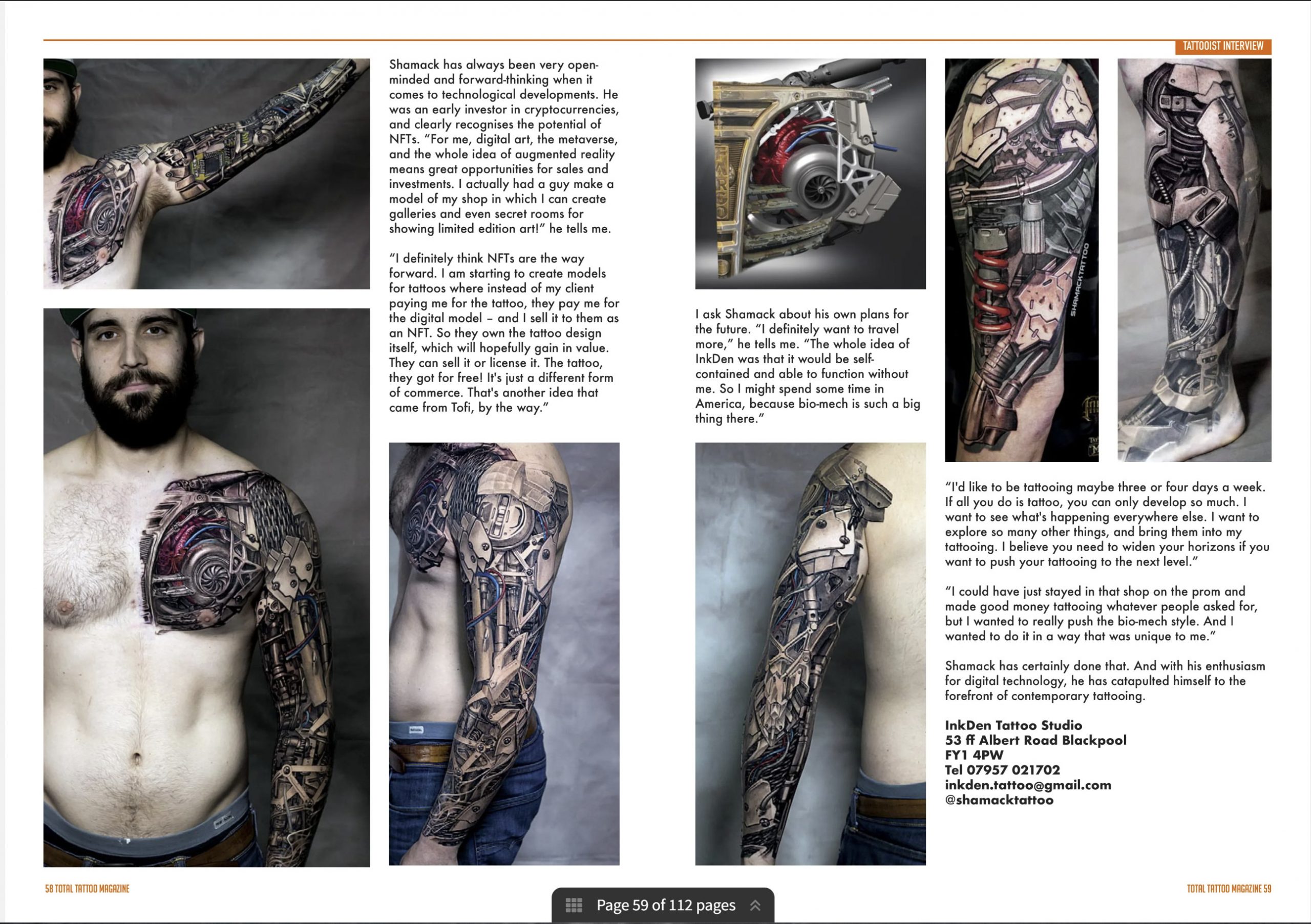
was an early investor in cryptocurrencies, and clearly recognises the potential of NFTS. “For me, digital art, the metaverse,
and the whole idea of augmented reality means great opportunities for sales and investments. I actually had a guy make a
model of my shop in which I can create galleries and even secret rooms for showing limited edition art!” he tells me.
“I definitely think NFTs are the way forward. I am starting to create models for tattoos where instead of my client
paying me for the tattoo, they pay me for the digital model – and I sell it to them as an NFT. So they own the tattoo design
itself, which will hopefully gain in value. They can sell it or license it. The tattoo, they got for free! It’s just a different form
of commerce. That’s another idea that came from Tofi, by the way.” I ask Shamack about his own plans for the future.
“I definitely want to travel more, ” he tells me. “The whole idea of InkDen was that it would be self- contained and able to function without
me. So I might spend some time in America, because bio-mech is such a big thing there.”
“I’d like to be tattooing maybe three or four days a week. If all you do is tattoo, you can only develop so much. I
want to see what’s happening everywhere else. I want to explore so many other things, and bring them into my
tattooing. I believe you need to widen your horizons if you want to push your tattooing to the next level.”
“I could have just stayed in that shop on the prom and made good money tattooing whatever people asked for,
but I wanted to really push the bio-mech style. And I wanted to do it in a way that was unique to me.”
Shamack has certainly done that. And with his enthusiasm for digital technology, he has catapulted himself to the
forefront of contemporary tattooing.
Ink Den Tattoo Studio
53 ff Albert Road Blackpool
FY1 4PW
Tel 07957 021702
inkden.tattoo@gmail.com
@shamacktattoo
TOTAL TATTOO MAGAZINE




